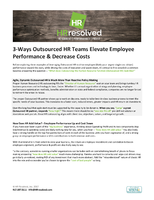Successful 60-Hertz Market Entry with Order for New Siemens "World-Record" Gas Turbine
Munich, Germany - Six gas turbines to start operation in U.S. - Nearly $1 billion in customer benefits
After a nearly ten-year development phase, Siemens has entered the market with its new generation of extremely energy-efficient gas turbines, the so-called H-Class. A leading U.S. utility is the first commercial customer. Starting in 2013, no fewer than six of the "world-record turbines," which will cut fossil fuel consumption in combined-cycle power plants by a third, will be in operation in the Sunshine State of Florida. By upgrading its power plants, the customer Florida Power & Light will achieve net savings of nearly $1 billion over the turbines' entire lifecycle. "The H-Class is a masterpiece of engineering and a model of energy efficiency. We're the first to the market. With this top-class Siemens product, we're now helping U.S. electric companies achieve the energy transformation being driven by President Barack Obama. We'll now be moving into other regional markets," said Siemens President and CEO Peter Loscher.
During his visit to a Siemens Wind Power rotor blade facility in Iowa at the end of April,
President Obama called for the U.S. to play a stronger role in renewable energies and the sustainable use of the world's natural resources. Compared to the solutions currently installed in combined-cycle power plants, the new generation of Siemens gas turbines consumes one-third less natural gas and emits one-third less CO2, while generating the same amount of power. CO2 emissions are a whopping 75 percent below those of coal-fired power plants. In addition, the turbines can go from standby to startup in five minutes and reach full power operation in only 15 minutes. They need only minutes to switch from full power to half power or vice versa, enabling them to optimally compensate for natural fluctuations in rapidly increasing grid feed-ins from wind and solar energy sources. Wolfgang Dehen, CEO of Siemens' Energy Sector, said: "This is a triple-win situation - for the customer, for the environment and for Siemens." Siemens expects the H-Class market worldwide to total at least ten turbines a year in the medium-term. Depending on specifications and equipment, the cost per turbine is in the two- to three-digit million range.
After a nearly ten-year development phase - including prototype construction and one-and-a-half years of field tests - marketing of the H-Class, which achieves a world-record-setting efficiency of more than 60 percent, has now begun. On average, combined-cycle power plants in the U.S. currently convert less than 40 percent of exhaust gases into electricity. Equipping all the country's combined-cycle plants with H-Class turbines from Siemens would yield as much additional power as 25 million Americans consume in one year - without increasing CO2 emissions. This additional power would have a retail value of up to $40 billion.
More than 800 Siemens employees participated in the development of this masterpiece of engineering. Multi-ton components and tiny elements are assembled with painstaking precision. Consisting of more than 7,000 individual parts, an H-Class turbine has an output equal to that of up to 1,200 high-performance sports cars. At 280 tons, each of the 60-Hertz gas turbines ordered for Florida weighs a little more than a fully fueled and fully loaded Airbus A340-300 with 300 passengers on board. The turbines are 11 meters long and about five meters in diameter. At 444 tons, the largest model currently available weighs as much as a fully fueled Airbus A380 and generates enough power to supply the energy needs of a city of 2.2 million inhabitants. Temperatures inside the combustion chamber reach up to 1,500 degrees Celsius, and the distance between the blades and the housing is as small as the thickness of a postcard. Turning at more than 1,700 kilometers an hour, some parts of the turbine blades exceed the speed of sound when in operation. In turbine technology, the letter "H" stands for the highest efficiency class currently available.
The gas turbines are part of Siemens' Environmental Portfolio. In fiscal 2009, the Portfolio generated revenue of some 23 billion, making Siemens the world's largest supplier of ecofriendly technologies. In the same period, Siemens products and solutions enabled customers to cut their CO2 emissions by 210 million tons - an amount equal to the combined annual emissions of New York, Tokyo, London and Berlin. The goal is to reduce annual CO2 emissions in 2011 by at least 300 million tons - the amount of CO2 currently generated in New York, Tokyo, London, Singapore, Hong Kong and Rome put together.
Siemens AG (Berlin and Munich) is a global powerhouse in electronics and electrical engineering, operating in the industry, energy and healthcare sectors. For over 160 years, Siemens has stood for technological excellence, innovation, quality, reliability and internationality. The company is the world's largest provider of environmental technologies, generating 23 billion - nearly one-third of its total revenue - from green products and solutions. In fiscal 2009, which ended on September 30, 2009, revenue totaled 76.7 billion and net income 2.5 billion. At the end of September 2009, Siemens had around 405,000 employees worldwide. Further information is available on the Internet at: www.siemens.com.
Siemens AG
Corporate Communications and Government Affairs
Wittelsbacherplatz 2, 80333 Munich
Germany
Media Relations: Alfons Benzinger
Phone: +49 9131 18-7034
E-mail: alfons.benzinger@siemens.com
Siemens AG
Wittelsbacherplatz 2, 80333 Munich
Germany




